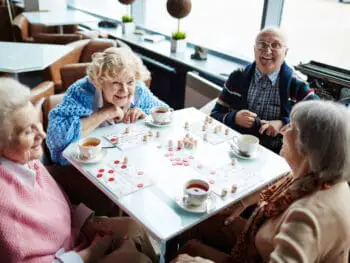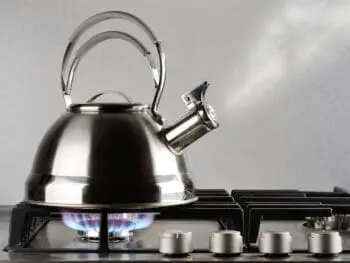“One good thing about music, when it hits you, you feel no pain!” —-Bob Marley
Actually, Bob Marley should have added that when music hits you, all you feel is sublime pleasure and peace. Let me start this article by asking you this – Do you have a song? The one piece of music that puts you in a pleasant mood even when your world seems to be crumbling around your ears?
If you are like me, it won’t be just one song but a whole playlist of favorites. While the song and the type of music can vary from one person to another, I am sure you will agree with me when I say that music has a universality about it. Some songs just make you feel good, no matter what and when.
Well, music therapy for older adults uses this very quality of songs and melodies to positively influence the mental and physical wellbeing and other aspects of life of seniors.
So, if you have an elderly parent/parents at home, and you want to make their golden years all the more golden, continue reading to know more about music therapy for elderly people. Let’s start with the basics…
What Exactly Are Music Therapy Interventions For Older Adults?
An evidence based approach, music therapy can be used in a multitude of ways to improve life quality for seniors. The best part is that music, in all its myriad facets, can be incorporated into a technique that feels completely natural and non-intrusive, yet is extremely effective.
Before I go any further into this explanation, let me tell you that music therapy is not just about playing your mom’s favorite song for her. Enjoying their favorite songs, undoubtedly sparks positive emotions in seniors. But, this is a more passive-receptive approach to using music.
While this works, in the elderly, more can be gained from active and receptive-active forms of music therapy that not only involve listening to music but call for active participation from seniors, in more ways than one.
And no, I am not only talking about dancing here, although that is one aspect of music therapy in seniors. The participation can come in a wide variety of forms and can be physical, emotional, spiritual, cognitive and/or creative. In fact, this is one of the best ways to engage more than just one of the senses in an activity that is innately pleasing.
Music Therapy Activities For The Elderly: How Do They Work?
The thing about music is that it’s processed in every part of the brain. So, its influence is not limited to a specific section of the noggin. However, the first impact of those melodious notes is on the auditory cortex that is linked to the brain’s limbic system. Think of this as the emotional and cognitive center of the brain.
The stimulation of this system helps older adults to learn new skills and relearn skills that have been forgotten. Plus, it helps to create bridges between knowledge instilled in the past with newly acquired information. So, we are talking about an improvement in both long term and short term memory and a healthy noggin to go with it.
In addition, dancing and other physical activities that are a part of music therapy help to improve coordination and even balance. Furthermore, music therapy can be used for reality orientation. Simply put, this is when songs from the past are used to invoke special memories and even offer a sense of timing such as the change in seasons or festivals.
Let me give you an example here. An older adult who suffers from Alzheimer’s and or dementia may not clearly understand the concept of Christmas. However, if a famous holiday song was played in the household during his younger days, listening to it again will lead to a sense of recognition, association and understanding.
The Benefits Of Music Therapy For Seniors
In the words of the legendary Billy Joel, ‘Everybody loves music.” And why not? I feel the Greeks were on to something in their belief that music, with its melodious progression and harmonious scales, is crucial for the development and maintenance of a sound mind. So, take a look at the many ways in which music therapy can benefit your elderly parents:
1. Get the wheels in that noggin moving: As I discussed, music impacts every part of the brain, including nooks and crannies that don’t get much action in later years. So, the first and the most conspicuous benefit of this intervention comes in the form of a marked improvement in cognitive skills.
Depending on the type of music therapy used, cognitive benefits can present themselves as improvements in: memory and recall, ability to communicate and express, comprehension and awareness and handling of oneself.
2. Chase away the blues: Imagine spending a lifetime in the thick of things and then suddenly finding yourself with nothing to do and a ton of spare time. It’s only natural to feel unwanted and left out, wouldn’t you say? Well, music therapy changes all of that for your elderly parents.
Because music therapy is not a passive act but involves a lot of interaction, it sparks a feeling of anticipation and excitement. If a family member or loved one participates in the sessions, all the better because then suddenly the older adult is no longer living on the fringes of family and society but is in the center of it, enjoying the best of what life has to offer.
3. Throw boredom out the window: The loss of work life and physical activity can cause the mind to quiet down, spurring feelings of boredom and loneliness. For seniors, who suffer from hearing loss, these negative emotions are simply magnified.
Music therapy can bring back the spark because it calls for the involvement of a twosome and if possible, a group. Simply put, it adds variety to life and we all know that variety is the spice of life.
4. Get up and get moving: All that sitting and lying down can be tough on the bones and the muscles, not to mention that the sedentary lifestyle doesn’t do much for the brain. Even if older adults cannot get up and dance, the bit of foot tapping, rocking and clapping can get the blood flowing and infuse the being with a sense of joy and excitement.
For seniors, who can still shake a leg, dancing is a fantastic way to maintain and even improve physical and mental health and wellbeing, without unduly stressing the body.
5. Bring back the positivity: With the use of the right songs and melodies, it is possible to bring back memories of happy events and moments. And do not underestimate the power of reminiscence.
Music therapy reminiscence can stop seniors, who suffer from Alzheimer’s and dementia, from sinking into the lonely, confusing darkness of their own minds. Such interventions keep older adults rooted into their current environment and connected to their loved ones.
6. Rein in the negative thinking: Often, the elderly don’t have enough to stimulate them mentally and physically, which leaves enough time and mental bandwidth on their hands to ruminate on the negative experiences and aspects of life.
Music therapy halts the cycle of negative thinking by drawing the attention of seniors towards enjoyment and other, more positive aspects of life.
7. Calm those nerves and usher in happiness: Depending on the health condition of an older adult, anxiety nervousness and agitation can become a part of daily life. Soon these emotions turn into aggression and depression.
Music therapy promotes the release of happy hormones in the body, which is a natural and effective way to rein in nervousness and irritation.
8. Kick stress to the curb: Music motivates movement, and movement in any form is a fantastic stress buster. So, another benefit of music therapy is its ability to keep stress at bay.
Now, let’s not forget that many age related ailments are triggered by stress or result in stress. With music you can stop the disastrous cause and effect cycle of stress and physical ailments.
9. Encourage social interaction: Often, music therapy is conducted in a group, which means your elderly parents get more social interaction. And, it’s a well-known fact that social isolation worsens dementia and speeds the progression of cognitive issues.
Music therapy offers a realistic and feasible opportunity to communicate and bond with others. This alone can bring about a tremendous improvement in physical, mental and emotional wellbeing.
10. Better sleep quality: Finally, nothing works better than calm, soothing music to beckon those zzz’s. Music therapy is proven to be effective against insomnia and restless sleep disorders.
In fact, such interventions were found to be almost as effective as mild to moderate strength sedatives. But unlike sleeping pills, they don’t leave seniors groggy and at risk of falling down.
Different Types Of Music Therapy For Elderly People
Earlier in this article, I briefly mentioned receptive and active forms of music therapy. These are two of the three fundamental approaches to using music therapeutically, with the aim of easing various physical and mental concerns faced by older adults.
Let’s talk a bit more about these basic forms and then I will tell you about the various techniques in each category.
1. Receptive: As you may have guessed, this involves receiving or listening to music. Make no mistake; although this form of therapy is passive it’s no less engaging for seniors. It can be coupled with a variety of other therapeutic interventions.
For instance, tracks that soothe and relax with tai chi, music that increases inward focus with meditation, nature sounds with binaural beats or isochronic tones for improving sleep and other such combinations.
Receptive music therapy is incredibly effective in promoting emotional wellness. Depending on the type of music chosen and the overall environmental setting, this intervention can help to alleviate stress and depression, enhance relaxation and reduce pain and the anxiety it causes.
Now, a lot of you may wonder how a simple song can help to heal the body. Actually, music does not work as a cure but it does improve a person’s coping mechanism, making it easier and more bearable to tide through mental and physical issues.
2. Active: This is where all the fun, excitement and creativity lie! The instruments used are simple; for instance, easy to play and learn percussion instruments, the harmonium or the keyboard or even digital sound creators.
The idea is to get older adults actively involved in the process of creating music. They could participate by learning to play an instrument, by imitating somebody who is playing a musical instrument or lending their singing skills to the making of the track.
Because physical activity is involved in the process, the benefits of active music therapy are not limited to the mind and the emotions alone. For example, learning to play the keyboard can give some much needed exercise to stiff finger and wrist joints.
A wind instrument or singing can help to improve respiratory health. Above all, the coordination skills needed to play a musical instrument or sing help greatly in enhancing brain plasticity. Not to mention that the mere act of mastering a new skill creates a sense of anticipation and achievement.
3. Receptive-active: These interventions combine receptive therapy with activities. In this form, seniors don’t learn to play music, but music is put to use in a whole lot of other ways.
For example, songs can be used: for a quick quiz, to discuss happy events from the past, to improve speech skills by asking a senior to complete the rhyme or to pen his/her own lyrics to an instrumental track. This form of therapy can be used to achieve very specific physical and mental wellness goals.
Now, that you know the basic categories of music therapy for seniors, as promised, I am going to tell you about the different techniques that are clubbed under them. Most of these call for the involvement of a qualified music therapist.
But fret not! I will tell you about music therapy ideas that you can use on your own with your senior parent. However, that’s for later. For now, let’s talk about why and when you ought to consider getting in touch with a music therapist for your elderly mom/dad.
- Using music for guided imagery: This method comes courtesy of a gifted musician and therapist, Helen L Bonny. It involves the use of western classical music and mental imagery guided through the words of the therapist. Sessions of the Bonny Method can last for up to 2 hours and provide a safe and effective vehicle for improving awareness and deeply exploring states of consciousness.
- The humming of music felt all over: Known as VibroAcoustic therapy, this intervention allows music to be felt not only through the auditory sense but by every part of the body. The therapist uses specialized tables and chairs that provide vibrating stimulus to the body in tandem with the beats of the music being played through the headphones. They call it the internal massage, and it is meant to relax and stimulate the brain and the body at the same time.
- Happiness through music: The Dalcroze Method works for the elderly with motor difficulties because it involves learning music. It is known to improve physical awareness among youngsters and seniors alike.
- Music to train those neurons: Neurologic Music Therapy (NMT) is an evidence based intervention that relies on the perception and reception of music in the brain to yield specific physical results. NMT therapists use music to train certain parts of the brain, improve neural connectivity and for building new neuropathways. In simple words, NMT is used to bypass or heal the areas of the brain that may be damaged due to a stroke, Parkinson’s, Alzheimer’s and other such conditions.
Music Therapy Activities For Older Adults That You Can Try At Home

1. Drum circle: This is a group activity and a lot of fun. So, it will be fantastic to get other seniors or even family members involved in this one. Especially, if you have kids who can participate in this activity, I promise everybody will have a good time.
You need simple djembe drums. The session can last for up to an hour and you can include such activities as talking exclusively through the drums or playing the drums in tune with a song running in the background, singing folk songs to drum beats and even mimicking the beats of the drums with claps.
2. Funny lyrics: Take a popular song and write your own funny lyrics and sing out the song aloud. Everybody in the group writes down their own lyrics and the participant, who creates the funniest words, get a small prize.
3. Sing along for all: Who said that only youngsters enjoy karaoke? If you have a unit at home, organize a small blast to (not from) the past party for your elderly parents and their friends. Play songs that were on the billboard when your mom and dad were in their twenties.
Also lookup the party scene of the time, so you can recreate some mother aspect that was a hit among youngsters at the time. The idea is to involve as many senses as you can and then have everybody take turns with the mic.
4. What happened then: This isn’t a group activity, so you can enjoy this one with your parents and perhaps involve your siblings in the mix. The idea is to play songs that your parents must have enjoyed in their younger days and ask them about famous incidents or events associated with the song or the artist in any way.
5. Bridging the age gap: This activity is one of my personal favorites because it can be enjoyed by family members across generations. It’s about bridging the age gap with the music that every generation favored.
For instance, play your mother’s favorite song for her and your kids and play a song that your kid likes for your parents. The idea is for every generation to discuss what they like/dislike about the music that the younger/older family members favor/favored. It can be the lyrics, the beats, the artist or any other aspect of the song.
6. The parent kid playlist: I like to think of this as a bonding activity, one in which you and your elderly parents create a music playlist together. Don’t forget to include songs that all of you enjoy and take the time out to listen to the playlist together. In fact, take the fun outside by listening to the playlist as you enjoy a leisurely walk in the park or when chilling on the patio.
7. Music bingo: Add a sense of excitement and winning to your music therapy sessions with the song bingo. Make a playlist of short clips of songs that your parents often listened to.
The bingo cards should have either the name of the song, the name of the movie that it was played in or the name of the artist. Play one clip at a time and the seniors in the group are supposed to cross out the link to the song from their music bingo cards.
8. What’s that sound: This one is for all you folks out there who enjoy instrumental music. It does take a bit of planning, but if your elderly parent has always had a soft spot for instrumental themes and music, it will be well worth the effort.
You will have to download clips of sounds made by various musical instruments. The aim is to listen to each clip and identify the musical instrument that was used to make the sound.
Safety Considerations When Choosing Music Therapy Ideas For The Elderly

The best part of choosing music therapy session plans for adults is that you can get as creative as you like. However, you do need to consider a few safety tips when choosing the activities and using music therapy in general. For instance:
Only happy music is allowed: If music has the strength to elicit happy memories, it also has the power to evoke negative emotions, and the last thing you want to do is leave your mom or dad sad after the music therapy session. So, be extra picky about the songs and music used in the session.
If you are not sure about how the elderly folks in your home will react to a particular song, err on the side of caution and opt for soft, soothing music that is relatively new to them. As you ease into the music therapy sessions, you can ask them for recommendations. Take the time out to discuss the significance of the songs they choose, so that you only go with those that will bring back fond memories.
Don’t overdo things: If your music therapy activities for older adults involve physical movement, limit the sessions to no more than 15-20 minutes. Keep an eye out for obvious signs of fatigue such as profuse sweating and labored breathing. Yes, moving about helps but there is no point in stressing out an ol’, weathered body.
Set the volume right: Regardless of the type of music used, make sure that you set the volume to a level that the seniors prefer. Older adults who have developed auditory issues will need headphones, and you will have to crank up the volume for them.
In contrast, those who don’t have auditory deficits may not be able to bear loud music for too long. In fact, some seniors also exhibit a marked aversion for fast-paced music. So, so start slow and low and then make adjustments based on feedback.
Music works, but not all the time: Undoubtedly, most people enjoy music, but sometimes an older adult may just not be in the mood for a song. And you will agree with me when I say that nobody enjoys doing anything that they don’t want to do. So, if it does not look like your parents are enjoying the session, cut it short and come back another day, so to speak.
Remember, the frustration of doing something that they don’t like/want to do can be intensely heightened in seniors who have speech problems or trouble expressing themselves. With these individuals, their facial expressions and hand gestures and obvious signs of discomfort or agitation will be your only cue to stop the music and have a go at it some other time.
The Beginning Of The Beginning…
And with that I have come to the end of this article. I have just one last bit of advice to give you, and this happens to be the most important. You really don’t have to wait for your parents’ health to go downhill before you start to use music therapy.
In fact, music also works exceptionally well when you use it to prevent the decline before it starts. And I bet your parents will love spending time with you, even if the bonding/re-bonding happens over a few good songs.
So, what are you waiting for? Put that mouse to work and create a playlist to start your parents on your very own brand of home-made and personalized music therapy. Here is wishing all seniors out there years of fun with foot tapping tracks and relaxation with soft songs!

















